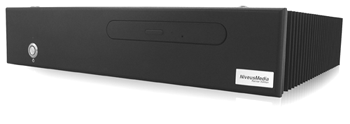Using a Media Center PC
| NOTE An alternative form factor, used by Shuttle and similar manufacturers, is to package the Media Center PC in a compact and somewhat portable cube. These small form factor (SFF) cabinets look a bit like the Mac Mini, and sometimes even come with a handle on top. While this design might look out of place in an audio rack, it does kind of fit in with shelf-based music systems. When you run MCE on a PC, you get what many are calling a Media Center PC. (Or, alternately, an entertainment PC or home theater PC.) So, you're asking, why would you want a Media Center PC? As I see it, there are two main uses for a Media Center PC:
Probably the most popular configuration is the home theater PC, as typified by Media Center PCs offered by Alienware, Hewlett Packard, NiveusMedia, and others. These PCs typically come with a big hard drive (120GB or more), built-in TV tuner (at least one, sometimes two for recording two programs at once), wireless networking (for connection to your home network and the Internet), CD-R/RW drive, DVD drive (optionally, a DVD recorder, for burning DVDs of the programs you record), and wireless remote control (to operate the Media Center from across the living room.) Look to pay anywhere from $1,000 to $5,000 for one of these things, depending on the features and configuration. Most of these Media Center PCs come in a form factor that isn't quite what you're used to with a desktop PC. As you can see in Figure 17.1, the perfect Media Center PC doesn't look like a PC at all; it isn't vertical, it's horizontal, typically about 17" wide and a few inches tall, in a cabinet that closely resembles that of most audio components. The goal is to have the Media Center look at home in a rack of audio and home theater components complete with the black metal faceplate used by most of these devices. Figure 17.1. A Media Center PC for home theater systems, from NiveusMedia looks just like any other audio/video component, doesn't it?
TIP Learn more about Windows XP Media Center Edition at Microsoft's Media Center Web site (www.microsoft.com/windowsxp/mediacenter/), or at the independent Web site called The Green Button (www.thegreenbutton.com), which is run by a bunch of MCE enthusiasts. It's a great place to find news, advice, plug-ins, and a lot more. In addition, many Media Center PCs go to some lengths to reduce the noise typically associated with personal computers. That means fewer, quieter fans or, in some instances, no fans at all, with either water cooling or large heat sinks to dissipate the normal heat buildup. |
EAN: 2147483647
Pages: 270
